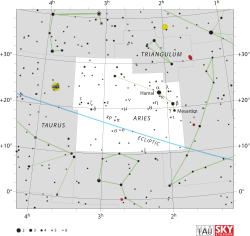35 Arietis
| 35 Arietis | |
 | |
| Observationsdata Epok: J2000.0 | |
|---|---|
| Stjärnbild | Väduren |
| Rektascension | 02t 43m 27,11185s[1] |
| Deklination | +27° 42′ 25,7233″[1] |
| Skenbar magnitud () | 4,64 (V)[2], +4,67 (V)[3] |
| Stjärntyp | |
| Spektraltyp | B3 V[4] |
| U–B | -0,62[5] |
| B–V | -0,112 ± 0,012[6] |
| Astrometri | |
| Radialhastighet () | 13[7] km/s |
| Egenrörelse (µ) | RA: +2,06[1] mas/år Dek.: -10,37[1] mas/år |
| Parallax () | 9,51 ± 0,85[1] |
| Avstånd | 340 ± 30 lå (105 ± 9 pc) |
| Absolut magnitud () | -0,46[8] |
| Detaljer | |
| Massa | 5,7 ± 0,3[9] M☉ |
| Radie | 2,2 – 3,9[10] R☉ |
| Luminositet | 870[11] L☉ |
| Temperatur | 17 520[12] K |
| Vinkelhastighet | 90[13] km/s |
| Ålder | 5,5 ± 4,7[9] miljarder år |
| Andra beteckningar | |
| HD 16908, N30 549, TD1 1609, AG+27 291, HGAM 167, PMC 90-93 68, TYC 1776-1395-1, BD+27 424, HIC 12719, PPM 91923, UBV 2703, FK5 94, HIP 12719, ROT 368, UBV M 9115, GC 3273, HR 801, SAO 75532, uvby98 100016908, GCRV 1534, IRAS 02405+2729, SBC9 139, WEB 2586, GEN# +1.00016908, JP11 689, SKY# 4083, YPAC 6, GSC 01776-01395, 2MASS J02432711+2742257, SRS 30094, Gaia DR2 127114543583090176[3][2] | |
35 Arietis, som är stjärnans Flamsteed-beteckning, är en dubbelstjärna[14] belägen i den norra delen av stjärnbilden Väduren. Den har en kombinerad skenbar magnitud på ca 4,64[2] och är svagt synlig för blotta ögat där ljusföroreningar ej förekommer. Baserat på parallaxmätning inom Hipparcosuppdraget på ca 9,5[1] mas, beräknas den befinna sig på ett avstånd på ca 340 ljusår (ca 105 parsek) från solen. Den rör sig bort från solen med en heliocentrisk radialhastighet av ca 13 km/s.[7]
Egenskaper
[redigera | redigera wikitext]Primärstjärnan 35 Arietis A är en blå till vit[15] stjärna i huvudserien av spektralklass B3 V.[4] Den har en massa som är ca 5,7[9] solmassor, en radie som är ca 2,2-3,9[10] solradier och utsänder ca 870[11] gånger mera energi än solen från dess fotosfär vid en effektiv temperatur av ca 17 500 K.[12]
35 Arietis är en enkelsidig spektroskopisk dubbelstjärna där närvaron av en följeslagare demonstreras av skiftningar i spektrumet för primärstjärnan.[16] Paret kretsar kring varandra med en omloppsperiod av 490,0 dygn och en excentricitet av 0,14.[14]
Referenser
[redigera | redigera wikitext]- Den här artikeln är helt eller delvis baserad på material från engelskspråkiga Wikipedia, 35 Arietis, 9 december 2020.
Noter
[redigera | redigera wikitext]- ^ [a b c d e f] van Leeuwen, Floor (November 2007), "Validation of the new Hipparcos reduction", Astronomy and Astrophysics, 474 (2): 653–664, arXiv:0708.1752v1, Bibcode:2007A&A...474..653V, doi:10.1051/0004-6361:20078357. Note: see VizieR catalogue I/311.
- ^ [a b c] "35 Ari -- Star", SIMBAD, Centre de Données astronomiques de Strasbourg, hämtad 2012-08-15.
- ^ [a b] ”Basic data: V* 35 Ari – Spectroscopic binary” (på engelska). Centre de Données astronomiques de Strasbourg. http://simbad.u-strasbg.fr/simbad/sim-basic?Ident=35+Ari&submit=SIMBAD+search. Läst 16 maj 2019.
- ^ [a b] Borgman, J. (December 1960), "Seven-Colour Photometry of O, B and A Stars", Bulletin of the Astronomical Institutes of the Netherlands, 15: 255, Bibcode:1960BAN....15..255B.
- ^ Crawford, D. L.; Barnes, J. V.; Golson, J. C. (1971), "Four-color, Hbeta, and UBV photometry for bright B-type stars in the northern hemisphere", The Astronomical Journal, 76: 1058, Bibcode:1971AJ.....76.1058C, doi:10.1086/111220.
- ^ van Leeuwen (2007). ”Hipparcos, the New Reduction” (på engelska). http://vizier.u-strasbg.fr/viz-bin/VizieR-5?-out.add=.&-source=I/311/hip2&HIP=12719. Läst 16 maj 2019.
- ^ [a b] Evans, D. S. (June 20–24, 1966). "The Revision of the General Catalogue of Radial Velocities". In Batten, Alan Henry; Heard, John Frederick (eds.). Determination of Radial Velocities and their Applications, Proceedings from IAU Symposium no. 30. University of Toronto: International Astronomical Union (published 1967). pp. 57–63. Bibcode:1967IAUS...30...57E.
- ^ ”35 Arietis” (på engelska). Universe Guide. https://www.universeguide.com/star/35arietis. Läst 16 maj 2019.
- ^ [a b c] Tetzlaff, N.; Neuhäuser, R.; Hohle, M. M. (January 2011), "A catalogue of young runaway Hipparcos stars within 3 kpc from the Sun", Monthly Notices of the Royal Astronomical Society, 410 (1): 190–200, arXiv:1007.4883, Bibcode:2011MNRAS.410..190T, doi:10.1111/j.1365-2966.2010.17434.x.
- ^ [a b] Pasinetti Fracassini, L. E.; et al. (February 2001), "Catalogue of Apparent Diameters and Absolute Radii of Stars (CADARS) - Third edition - Comments and statistics", Astronomy and Astrophysics, 367 (2): 521–524, arXiv:astro-ph/0012289, Bibcode:2001A&A...367..521P, doi:10.1051/0004-6361:20000451.
- ^ [a b] Hohle, M. M.; Neuhäuser, R.; Schutz, B. F. (April 2010), "Masses and luminosities of O- and B-type stars and red supergiants", Astronomische Nachrichten, 331 (4): 349, arXiv:1003.2335, Bibcode:2010AN....331..349H, doi:10.1002/asna.200911355.
- ^ [a b] Zorec, J.; et al. (July 2009), "Fundamental parameters of B supergiants from the BCD system. I. Calibration of the (λ_1, D) parameters into Teff", Astronomy and Astrophysics, 501 (1): 297–320, arXiv:0903.5134, Bibcode:2009A&A...501..297Z, doi:10.1051/0004-6361/200811147.
- ^ Abt, Helmut A.; Levato, Hugo; Grosso, Monica (July 2002), "Rotational Velocities of B Stars", The Astrophysical Journal, 573 (1): 359–365, Bibcode:2002ApJ...573..359A, doi:10.1086/340590.
- ^ [a b] Eggleton, P. P.; Tokovinin, A. A. (September 2008), "A catalogue of multiplicity among bright stellar systems", Monthly Notices of the Royal Astronomical Society, 389 (2): 869–879, arXiv:0806.2878, Bibcode:2008MNRAS.389..869E, doi:10.1111/j.1365-2966.2008.13596.x.
- ^ "The Colour of Stars", Australia Telescope, Outreach and Education, Commonwealth Scientific and Industrial Research Organisation, December 21, 2004, archived from the original on March 10, 2012, hämtad 2012-01-16.
- ^ van Rensbergen, W.; De Loore, C.; Jansen, K. (February 2006), "Evolution of interacting binaries with a B type primary at birth", Astronomy and Astrophysics, 446 (3): 1071–1079, Bibcode:2006A&A...446.1071V, doi:10.1051/0004-6361:20053543.





